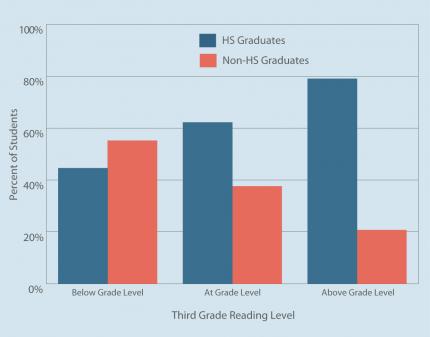Third Grade Reading Level Predictive of Later Life Outcomes

Chapin Hall researchers looked at school data over time to understand how students’ third-grade reading level relates to four educational outcomes: eighth-grade reading performance, ninth-grade course performance, high school graduation, and college attendance. Because third-grade reading level is linked to these long-term outcomes, teachers and programs can use that information to identify students most in need of support while they are still in elementary school.
What we did
We divided 26,000 students in Chicago Public Schools into three groups based on their third-grade national percentile rankings on the Iowa Tests of Basic Skills (ITBS). Students who scored below grade level were below the 25th percentile nationally, students who scored at grade level were between the 25th and 74th percentiles nationally, and students who scored above grade level were at or above the 75th percentile nationally. We then compared educational outcomes across the three groups for the full cohort, as well as for subpopulations defined by gender, race, and prior experience with the foster care system.
What we found
Reading level is linked to later educational outcomes:
- Third-grade reading level is a significant predictor of eighth-grade reading level.
- Eighth-grade reading in turn is a significant predictor of ninth-grade outcomes and differences in graduation and college enrollment rates, although the school a student attends in ninth grade is also significantly related to these outcomes.
- In addition, students who read above grade level in the third grade enrolled in college at higher rates than their peers who read at or below grade level. This pattern persisted even among high school graduates.
Male students, African American students, and students who ever spent time in the foster care system are more likely to be reading below grade level in the third grade.

What it means
Third-grade reading levels offer an important indicator of students’ academic trajectories and an opportunity for targeted intervention with at-risk children while they are still in elementary school. This is especially important for certain vulnerable populations, such as children in foster care. Previous research has shown that children involved with the child welfare system read at levels below their peers and have slower improvement over time.
Implementing programs that support struggling students before high school is essential. Students who are better prepared for a successful ninth grade year are more likely to have positive future outcomes, regardless of third grade reading status. The sooner that struggling readers are targeted for supports, the easier it is to ensure that students are progressing on course toward strong performance in ninth grade, high school graduation, and college enrollment.



 Thank you for your interest in Chapin Hall’s research. Please share some information to access this file.
Thank you for your interest in Chapin Hall’s research. Please share some information to access this file.